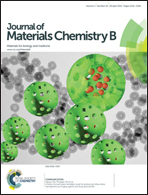Detection of human immunoglobulin G by label-free electrochemical immunoassay modified with ultralong CuS nanowires†
Abstract
Ultralong copper sulfide nanowires (CuSNWs) were synthesized via a simple wet chemical route. Due to the desired surface charge characteristics and attractive electrocatalytic activity toward the oxidation of ascorbic acid, such ultralong one-dimensional nanomaterials provided an interesting platform for electrochemical signal amplification. By immobilizing an anti-IgG antibody on the chitosan (CS)–CuSNWs film, a novel label-free electrochemical immunosensor was thus developed for detection of human immunoglobulin G (IgG). Various experimental parameters were studied, and the interference effects from other proteins were checked. Under the optimum conditions, the decrease of the amperometric signal presented a linear relationship in the IgG concentration range of 0.001–320 ng mL−1 with a detection limit of 0.1 pg mL−1 (S/N = 3). The practical application of the fabricated immunosensor has also been demonstrated by detecting IgG in real human serum samples. The satisfactory results hint the significant potential in clinical analysis.


 Please wait while we load your content...
Please wait while we load your content...